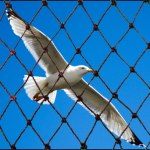Bird Netting For Warehouses

Pest birds can be an expensive and a hazard nuisance especially when they nest and assemble together in warehouse, hangars, under overhang or other large roofed shelters. But credit to bird netting since many of these issues can now be avoided.
Apparently, the most common problems that pest birds usually cause are their droppings. These droppings can quickly downpipes and clog gutters. They can as well cause rooftop turbine ventilators, ceilings doors and siding windows to seize up. They can quickly block security cameras, light sensors and weaken corrugated metal surfaces.
If left unchecked, these droppings can also result to structural damages and huge costs of maintenance. Equally problematic, droppings deposited on the entrances or fire escapes can form a “slip and fall” hazards for repair crews which might become a huge liability to private and public institutions. Bird netting can resolve these issues by keeping pest birds out though the use if a proven humane alternatives. Without bird netting, one may have to compete with the irritating or incessant noise which pest birds normally produce when they are gathering in big numbers. In warehouse for instance, bird droppings can destroy
finished products in storage areas and loading bays. They can stain and damage goods severely and mar the initial appearance of finished products.
Pest birds can as well be a health hazard by carrying and transmitting over 60 known diseases. Feral pigeons and sparrows can carry bacteria which causes Salmonellosis. Bird droppings together with their nestling materials have insects and mites which can damage food, property and fabrics which are stored in warehouses.
Luckily, bird netting provides and efficient bird control solution which is ideal for a wide range of industrial and commercial uses. This application can control many species of birds and is largely recommended as a bird deterrent by many architects. Some bird netting is UV stabilized, rot, waterproof and flame resistant. It comes in variety of sizes to enable full control of pest birds. Large birds such as seagulls and pigeons recommend a
1.5-2 inch mesh size. For smaller birds such as starlings and sparrows, a 0.75 inch mesh size is however recommended.

